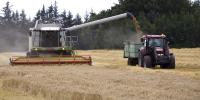EU consumption of crops for biofuels could feed around 150 million people

Exports of cereals and vegetable oil from Russia and Ukraine have been halted due to the tragic war in Ukraine. And it will likely be affected for some time to come. The already relatively tight supply of basic food to the world market has, as such, become even tighter - leading to significantly increased food prices.
This will inevitably affect the poorest populations in countries most dependent on imported cereals and vegetable oil, such as countries in the Middle East, Horn of Africa, and North African countries.
The gravity of the situation is heightened by the fact that in the EU, we use vast quantities of crops for biofuels. Crops that, instead of feeding people, end up in the tanks of petrol and diesel cars. Based on available data from a number of international sources, it can be estimated that the energy in the crops used in the EU for liquid biofuels is equivalent to the energy in the food that could "feed" around 150 million people. There is no precise estimate of this ratio. The calculation should be seen as an educated guess as to the size of the problem. It illustrates an acute dilemma facing European agriculture: it is unsustainable to use so much agricultural land to grow 'energy crops' while we face a growing food crisis.
In the EU, we can immediately alleviate some of the crisis by reducing our use of agricultural land to produce bioenergy - both bioenergy for biogas production and for the production of liquid biofuels. Instead, we could produce crops for direct human consumption or animal feed.
The following estimates of the scale of EU biofuel production and consumption, and the alternative use of the energy in them for human food, clearly illustrate an immense potential to mitigate the looming global food crisis by reducing the use of crops for biofuels.
EU’s production and consumption of biofuels
Large quantities of liquid biofuels are consumed in the EU. In 2020, the EU Commission estimated consumption at 15,655 kilotonnes of oil equivalent (ktoe). Liquid biofuels are typically bioethanol and biodiesel, and in 2020 in the EU, 3.9% was added to petrol and 6.6% to diesel in terms of energy content.
Bioethanol is produced mainly from cereals (typically wheat and maize) and sugar (usually from sugar cane and, to some extent, sugar beet), while biodiesel is produced from oil-bearing crops such as rapeseed, palm, soy, and sunflower, according to the European NGO Transport & Environment.
However, about 22% of biodiesel oil is produced from waste, which may be used as cooking oil, dead animals, etc., while 4% of bioethanol is produced from waste/residual streams. Thus, this part of the liquid biofuels does not contribute to reducing food supply. In addition, an unknown proportion of bioethanol is produced from what is called "secondary grain," i.e., grain that has become moldy or otherwise damaged so that it cannot be used for food or feed. It is assumed below that this proportion is relatively small and therefore neglected. In addition, a very small amount of bioethanol is produced from wood and straw in the EU. In the following, this share is also neglected, as according to the USDA & GAIN Network, it appears to represent less than 1% of bioethanol.
This means that 78% of biodiesel and 96% of bioethanol are produced from crops that could otherwise have been used for human food or animal feed. European liquid biofuel production in 2020 was slightly higher than consumption at 15822 ktoe, so the following calculation assumes that all liquid biofuel consumed in the EU is produced in the EU, even though liquid biofuels are both imported and exported to and from the EU.
Alternative use for human nutrition
Assuming that an average person (70 kg with "normal activity level") should consume about 2100 kilocalories (kcal) daily and that the energy of the food consumed is used 90%, the 15655 ktoe used for liquid fuels in the EU can be converted into "energy" to feed about 150 million people per year.
Obviously, a number of caveats must be made to this simplistic calculation. Firstly, humans cannot live on wheat, maize, rapeseed oil, etc., alone, so this figure should be seen as an indication of how much energy is actually converted into liquid fuels in the EU compared to the energy intake of our food. Secondly, some of the energy is lost when the grain is converted into bioethanol. Here, an energy loss of about 50% of the content of the original grain is expected, but on the other hand, a very large part of the lost energy is stored in the residual DDGS (Dried Distillers Grains), which is used as animal feed.
The same is true for biodiesel production, where the residue can be, for example, rapeseed cakes or soybean meal, both of which are used for animal feed. In what follows, energy losses from converting crops to liquid biofuel are not taken into account, although they undoubtedly will be present and will make the number of people who could be "fed" even larger. However, it can be difficult to specify exactly how large this is, and when the energy stored in the residues is considered, the energy loss is deemed to be relatively small. In addition, other substances are extracted from the residues, for example, in the pharmaceutical and other sectors, which are also not taken into account in the calculations.
Cultivation of fallow fields does not pay much compared to what biofuels swallow
It is thought-provoking that the EU has just decided that in 2022 it will be possible to cultivate set-aside land from what is called EFA land. EFA stands for Encological Focus Area and represents 5% of the EU's agricultural land. Only a part of the EFA area is actually set aside, and Danish researchers estimate, according to Børsen, that 10-12 million tonnes of wheat could be grown on land set-aside in the EU.
This may sound like a lot when you consider that the average Danish cereal harvest is 9-10 million tonnes per year. But if you compare that with the production of liquid biofuels, the energy in the possible production from set-aside land is only about a quarter of the energy used to produce liquid biofuels.
15 million loaves of bread a day instead of biofuels
The European NGO Transport and Environment have made various calculations to illustrate the same issue. Most recently, they have published a calculation showing that 15 million loaves of bread could be produced every day from the crops we convert into liquid biofuels.
In the summer of 2021, they published another report concluding that the production of liquid biofuels over the past ten years in the EU has led to the deforestation of land the size of the Netherlands, and if this deforestation was taken into account, the CO2 emissions from biofuels were significantly higher than from equivalent fossil fuels.
However, some specific liquid biofuel production may have some climate benefits. On average, however, it appears that liquid biofuel production is associated with little, no, or even a negative effect on greenhouse gas emissions. This is, for example, also confirmed in a recent US study on bioethanol production from corn.
Reduced consumption of crops for biofuels can mitigate the food crisis
As such, there are several guesses as to exactly how much the EU's consumption of biofuels reduces food supply and CO2 emissions. But it is indisputable that many people could be fed each year with energy from crops that we currently put in the tanks of our petrol and diesel cars. Therefore, in the current critical situation for food supply, a relevant EU action could be an immediate change of the biofuel EU blending requirement so that it can be met to a much lesser extent by biofuels. Such an action would indirectly free up land for food production in the current critical global food supply situation.
Politically, Europe is looking for answers to the food crisis, and so far, the focus has been on fallow land. Denmark and the EU should instead focus on measures that both increase food production here and now and support climate action and the way out of dependence on Russia and fossil fuels. In concrete terms, Denmark should take the lead in rapid political decision-making in the EU, ensuring that:
- The EU suspends the blending requirements a and changes them so that CO2e displacement cannot be met through crop-based biofuels; instead, the focus will be solely on electrification of transport
- Stops the option to meet the CO2e displacement requirement in Denmark through crop-based biofuels, thus freeing up land for food production. The Minister can do this immediately, as the Sustainable Biofuels Act (Section 3(3)) provides a legal basis for reducing the requirements concerning incorporation.
In 2020, the EU consumed 15,655 ktoe of liquid biofuels and produced 15,822 ktoe.
Units
ktoe: kilo tonne of oil equivalent = equivalent to energy in 1000 tonnes of crude oil.
1 ktoe crude oil = equivalent to approximately 42,000 gigajoules [GJ]
1 GJ = 239,000 kilocalories [kcal]
1 ton of grain = 15 [GJ]
Calculation of energy in liquid fuels
The consumption of liquid biofuels contains an amount of energy equivalent to:
15655 ktoe - 42000 ≈ 650,000,000 GJ ≈ 157,000,000,000 kcal.
The Danish Health Authority states that a 70 kg person with normal activity needs about 2100 kcal/day. It is assumed that 10% of the energy is not used (passes through the human body), i.e., 2100 - 1.1 ≈ 2300. Thus, the amount of energy in liquid biofuels corresponds to the following number of the average person's energy intake:
157,000,000,000/(2300 - 365) ≈ 187,000,000 persons/year.
Approximately 78% and 96% of biodiesel and bioethanol, respectively, are based directly on the conversion of crops to liquid biofuels (USDA & GAIN, 2021). A weighted average of this shows that about 80% of liquid biofuels are based on crops. Therefore, subtract 20% from 187,000,000 - 0.8 ≈ 150,000,000 people/year
The conclusion is that the amount of energy we produce on European fields and convert into liquid biofuels consumed in European cars is equivalent to the energy needed to feed 150,000,000 people/year.
The energy of fallow land
It is estimated that around 11 million tonnes of cereal production could be increased on EU’s fallow land. Since the energy in 1 tonne of wheat is equivalent to 15 GJ, the total energy in the cereals likely to be grown on EU’s fallow land is 11 million tonnes - 15 GJ = 165 000 000 GJ. Since the energy used for the production of liquid biofuels was calculated at 650,000,000 GJ, the energy in cereals grown on fallow land is 650,000,000 GJ/165,000,000 GJ ≈ 4, which means that we use four times as much energy from crops grown on EU land each year for the production of liquid biofuels as we could produce by suspending set-aside in the EU.
